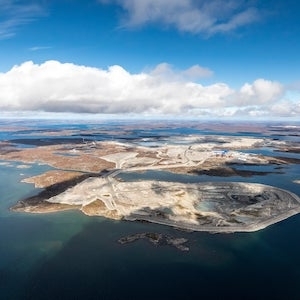
At “Diamonds From All Angles,” a recent half-day virtual conference organized by the Accredited Gemologists Association, Paul Zimnisky, an independent diamond industry analyst based in New Jersey, shared his macroeconomics-flavored perspective on the diamond market in 2024.

“I’m still forecasting that demand will be down, probably by a low- to mid-single-digit percentage year over year, in 2024,” Zimnisky said. “The next big catalyst will be to see if the Federal Reserve starts to reverse some of that interest rate hike cycle over the next six to 12 months. Something like that could stimulate consumer demand.”
Below, we offer additional excerpts from Zimnisky’s illuminating presentation, including the outlook for natural diamond production, how a “lukewarm” economy is affecting discretionary spending, and what has propelled the rise of lab-grown diamonds.
On the volatility of the past four years
“The last four years have been highly unusual. Obviously, the lockdowns in 2020 were followed by record demand in 2021 and 2022. The last 18 months or so, we’ve been dealing with an overhang. We had diamond prices make an all-time high in the first quarter of 2022, according to my proprietary rough diamond price index.
“Since then, prices have come off anywhere from 20% to 30%, depending on the category. So it’s just been breakneck volatility. And the fun continues. Now we’re dealing with sanctions on Russian diamonds. We’re dealing with a significant macroeconomic slowdown in China. De Beers is now up for sale. The list goes on and on.”
On natural diamond supplies
“I’m forecasting that global natural diamond production will be approximately 115 million carats this year. I think that’s a relatively sweet spot for production. If we look at some watermarks—for instance, in 2017 production was 150 million carats. …2020 production was about 110 million carats; notably, that was the lowest level of output since the 1990s. So if we look at the previous range of production, we’re kind of towards the lower end of that.
“If we do have lower supply, it should theoretically at least allow for higher prices if and when we see an increase in relative demand. Obviously, we don’t want an oversupplied market, but you also want enough core supply that diamonds can remain a relevant luxury product.”
On upcoming diamond production
“There’s only one major new mine of significant size that’s commencing production this year. It’s the Luele mine in Angola. And if we look at future production catalysts, there’s really not a whole lot on the horizon.
“We’re in this phase where these legacy mines are getting older. Production is declining. Some of them are reaching depletion and closing. There just aren’t a whole lot of significant new sources of supply—and that’s even if we’re looking 10, 20 years into the future. At the end of the day, with most commodities, and diamonds are in this category, as the price of the commodity goes higher, typically that drives economics and allows new projects to come online.
“Diamonds are somewhat unique given the long lead time to put new mines into production. The Gahcho Kué mine in Canada, which came online around 2016, I think that literally was 25 years, the process to finally bring that online. So there’s a long lead time to bring these new products online, and it kind of gives you an idea of what supply is going to look like into the future.”
On diamond demand
“Diamond prices, there’s always going to be short-term volatility. A great example of that was what we’ve seen the last few years where we went from a market where diamond stocks were sold out in early 2022, and then the industry aggressively restocked just as some of these demand drivers were starting to reverse. The stimulus ran out. People were able to go out and spend money on these experiential things. So that kind of leaves us in a situation today where I would say the diamond supply chain is still overstocked. I think it’s going to take some time to de-stock it.

“But I think that’s going to be worked through mostly in 2024 and then 2025. If we’re looking at demand, it’s important to remember that diamonds tend to correlate quite highly with GDP.
“If we’re looking at just economic growth in the U.S., you could certainly make the argument that the economy is outperforming relative to expectations. If we’re looking at government economic action with the Federal Reserve, we saw the most aggressive sequence of interest rate hikes probably since the 1980s over the last few years. Obviously, that was meant to try to quell the inflation problem, which was a problem that was arguably caused by too much fiscal stimulus.
“Inflation is still stickier than I think a lot of people would like it to be at this point. It’s definitely impacting consumer spending ability on more discretionary items like diamonds. But at the end of the day, most consumers are still working. They’re gainfully employed, and they’re doing the best to deal with the impacts of inflation. The consumer economy in the U.S., it’s not cold, it’s not hot. It’s moderate, maybe lukewarm.”
On lab-growns’ effect on the natural market
“I’ve been following this very closely since about 2015. The product went mainstream in maybe 2017, 2018, and then it just went crazy in 2021 and 2022.
“We’ve seen an explosion in supply. We’ve seen prices come down and a pretty consistent trend. In theory, we can produce as many lab diamonds as we want. They’re getting to the point where they could produce the sizes, the colors, the clarities that they want. And that’s just something that comes with advancements and production technologies for a manufactured product like this.

“If we’re looking at the impact that lab diamonds are having on natural diamonds, it’s certainly a significant sensitivity. It’s impacting the supply side of the equation. If we go back to, say, 2015, lab diamonds were probably, at best, 1% of global diamond jewelry demand. This year, I’m forecasting that we’re going to breach 20% for the first time.
“Natural diamonds still dominate diamond demand globally. But obviously, coming from essentially a base of zero, the growth has been extremely aggressive. It’s been extremely rapid. And there’s been a lot of volatility around the product that I think a lot of people in the trade weren’t expecting.”
On why lab diamonds have struck a chord with consumers
“If you look at the driving factor for the product, part of it is the novelty. It’s been a long time since the diamond industry has had something exciting and new to bring to customers. Customers always want newness. That was part of it. At the end of the day, it’s definitely the lower price point that’s driving the consumer interest.

“But the other factor to keep in mind is that a lot of retailers really adopted the product. They saw it as an opportunity to drive their profit margins. And the profit margins for lab diamonds—on a relative basis, at least—are still significantly higher than that of a natural diamond. So there’s really been an incentive for a lot of retailers to sell the product, and not only sell it, but maybe push it more so than natural diamonds because they wanted to capture that profit margin.
“As the price comes down—you’ll see a lot of cases where lab diamonds sell for a 90% or even a greater discount than that of an equivalent natural diamond—we’re getting to the point where the price points are getting so low, even if you have that fat relative profit margin, your overall profits for your business are going to take a hit just because your top line is going to be impacted.
“Now the question becomes, this year and going into 2025: Will these reduced profit margins for lab diamonds ultimately lead to a pivot in a lot of jewelers’ propensity to push lab diamonds over natural diamonds? If that happens, that could certainly be a big catalyst for the natural diamond industry.”
Top: Illusion bezel ring in 18k rose gold with 2.52 ct. faint pinkish brown lozenge step-cut diamond, $81,660; Rahaminov
- Subscribe to the JCK News Daily
- Subscribe to the JCK Special Report
- Follow JCK on Instagram: @jckmagazine
- Follow JCK on X: @jckmagazine
- Follow JCK on Facebook: @jckmagazine







